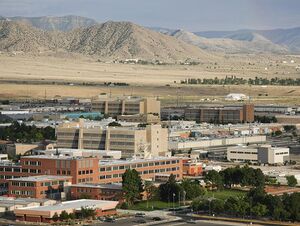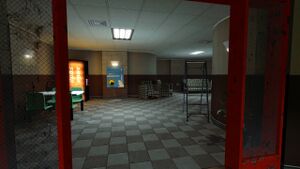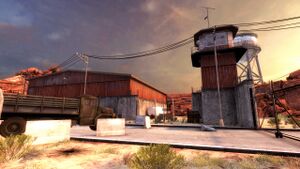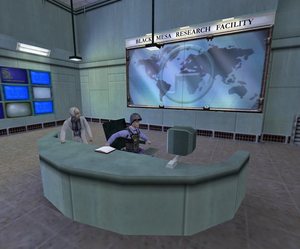Black Mesa Research Facility
 Logo used from 1991 to 2000, up until its dissolution. | |
 The above-ground section of the facility, with most of it's square footage being underground. | |
| Privately-held company | |
| Industry | Advanced Physics |
| Fate | Defunct; Resonance Cascade |
| Founded | January 11, 1945 |
| Founder | |
| Defunct | December 12, 2000 |
| Headquarters | Black Mesa, New Mexico, United States of America |
Key people | |
|
| |
|
| |
| Total assets |
|
Number of employees |
|
| Divisions |
|
| Subsidiaries | |
Black Mesa Research Facility (or officially; the Black Mesa Advanced Research Facility, and formerly; Black Mesa Research Foundation (1945–1956)) was an American information, data, advanced physics and federally funded research and development center in Black Mesa, New Mexico, United States. Founded in 1945, the laboratory was owned by private holder, Wallace Breen, who was also the founder of Black Mesa in 1945, and was administered by University of New Mexico's Physics Institute. While the facility ostensibly conducts military-industrial research, its secret experiments into teleportation have caused it to make contact with the alien world of Xen, and its scientists covertly studied its life-forms and materials. In a catastrophic event known as the Black Mesa Incident, the anti-mass spectrometer experiment 12-06-2001 conducted on Xen Crystal Sample GG-3883, caused a resonance cascade that caused the destruction of the facility before the destruction of the site by a nuclear weapon on 7 December 2000.
The science foundation was created between Wallace Breen, Jonathan Whitehead, and a couple other colleagues at the University of New Mexico's Physics Institute, who began experimenting with advanced physics after receiving governmental support by the team behind the Manhattan Project, and the (at the time) currently active Nuclear Weapons Program in the United States. Breen and Whitehead had temporary positions in the Nuclear Weapons program, which assisted in their high-ranking positions in the Black Mesa Research Foundation as they held high ranks in the team given to them by unknown benefactors that Wallace Breen has never described, a so called G-Man. In the middle of the 20th century, Black Mesa had purchased the Black Mesa Facility from the United States government as it had been abandoned due to issues with water-leakage, and with the prior experience with nuclear weapons by Breen and Whitehead, were given limited autonomy with the nuclear weapons located at the site, forcing them to disassemble the nuclear weapons if they were to hold such material.
In the late 20th century, Black Mesa had grown a positive reception in the Physics & Science field, having contributed much to the advancement of both fields through their teleportation technology that they had mastered through out the 60s and 70s, being one of the main rivals against former Research and Development company, Aperture Science, who had lost their spot as the number one science company in the country to Black Mesa themselves, having gone bankrupt by 1997. Black Mesa had access to advanced teleportation technology and alternate dimensions, but had no access to studying materials from the alternate dimensions, until the creation of the Anti-Mass Spectrometer by the Sector C team, gained notoriety from the Science field because of its usefulness in identifying new materials on Earth and off-world, becoming incredibly popular amongst scientists who attempted to replicate such machines, Arbeit Laboratories being a famous example of one.
Black Mesa was previously famous for their teleportation technology among the physics science field, and held the 1999 Nobel Peace Prize for the Sector C Anti-Mass Spectrometer team, which included Colette Green, Cheryl Hicks, Gina Cross, Eli Vance, Isaac Kleiner, and the head of the facility, Wallace Breen. Until December 6, 2000, which was the date of the aforementioned Resonance Cascade that destroyed the facility, and also caused the Xen Invasion and later Seven Hour War. In the early morning, a system crash caused by a massive email caused the Black Mesa IT Division and Security Division to lose all data on their files, having to recover them from the servers, which also added onto by the fact the Anti-Mass Spectrometer was forced to turn to 101 percent by Black Mesa Administrator Breen, which caused several electronics in the facility to fail or explode from the overexertion of the technology at the facility. Gordon Freeman was later described as being tardy to his job as the materials handler for the experiment, before physically pushing the sample into the Anti-Mass Spectrometer as it functioned, and causing the explosion that caused the Resonance Cascade.
History
1945–1953: Foundation, participation in the US Nuclear Weapons program, and search for research facility
In 1945, the two founders, Wallace Breen and Jonathan Whitehead were studying at University of New Mexico's Physics Institute when they formed the company, Black Mesa Research Foundation on the eleventh, having been joined by several former Manhattan Project employees, formed the research foundation in the basement of the Institute after the university gave permission for them to use it in specific schedules to conduct research on nuclear physics separate from the United States Nuclear Weapon Program, despite being connected to it very loosely. For a while, one of the main influences for the physics research done at the Black Mesa Research Foundation was Aperture Innovators, which used their advanced physics and scientific knowledge to make shower curtains appear more hygienic, which influenced Black Mesa at the time because the foundation sold important physics research and nuclear material to nuclear power plants and US Government entities that they had access to.
In 1948, Breen and Whitehead were approached by the United States Atomic Energy Commission (AEC) to assist in the production of nuclear weapons, having an important hand in the calculations of several tests in Operation Sandstone, especially the bombs X-Ray and Yoke, with the foundation supplying the government with nuclear material to help assist in the construction of these bombs. In return, the AEC paid Breen and Whitehead US$14.3 million dollars in return for their service in the production of nuclear weapons, but also forced them to sign a non-disclosure agreement, and Breen at the time had some reservations about helping in the production of weapons of mass destruction, saying later on that he had regrets and that he didn't want to assist in the production of weapons that could hurt the common man. Whitehead signed the non-disclosure agreement, and were paid US$23.5 million for the atomic research they also supplied to the AEC for nuclear weapon production.
In the early 1950s, Black Mesa sought out to purchase the Black Mesa Missile Complex from the United States government, and use the facility to produce more research based on their already existing products. Jonathan Whitehead at the time had been suffering from lung cancer at the time because of a couple of experiments that took place in the late 1940s that he oversaw, leaving him with severe lung damage and he would later pass away from lung cancer and severe lung damage in 1952, before the purchase of the Black Mesa Research Facility. Wallace Breen also took over his role and decided to go through with the purchase of
1953–1957: Purchase of the Black Mesa Research Facility, renaming, and First scientists
1957–1961: Opening of the first particle accelerator, experiments on teleportation technology
1961–1966: Interdimensional teleportation technology, Government grants, and Government involvement
1966–1970: Competition with Aperture Science, and Nuclear Weapons research
1970–1979: First plans of an Anti-Mass Spectrometer, and Research on Landmass–Landmass teleportation
1980–1986: Opening of Sector C Test Labs, Sector E Biodome Complex, and Sector F Lambda Complex
1987–1993: Development of the Anti-Mass Spectrometer, second government grants, plans of public-holding, and Sector H Information Technology
1993–1999: Recon teams to Xen, study of Xen species, and Nobel Peace Prize
1999–December 5, 2000: Year 2000 problem, employment of Gordon Freeman, and the acquirement of the Port Richmond Water Pollution Control Plant
December 6, 2000–December 7, 2000: Resonance Cascade, Dissolution of Black Mesa, and the destruction of Black Mesa
Company information
Hazards
On-site facilities
Organization and Administration
Sectors
- Sector A Training Facility; held the training facilities for the employees that used the Hazardous EnVironment Suit, often called the Hazard Suit, for convenience, with the only confirmed users at the time of the Black Mesa Incident being Gordon Freeman and an unnamed security guard. It featured several levels of obstacle courses for the Hazard Suit to train with, to train the user for Xen research and handling of Xen crystals for the Anti-Mass Spectrometer. It was connected to the rest of the facility by the Sector A Tramline.
- Sector B Coolant Reserve; Sector B held the Coolant that was intended for the various test silos that the facility held, and was constantly monitored by several Black Mesa Personnel until the Black Mesa Incident took place, with the entire sector being destroyed by a massive explosion in one of the coolant tanks, with one tank remaining for the only test silo that reported activity during the Black Mesa Incident, which was activated by Gordon Freeman, it was at the time unknown as to why the silo was activated by Freeman, but it is still debated. It was connected through the rest of the facility by elevator from Sector C.
- Sector C Test Labs; Sector C Test Labs held the Anomalous Materials Laboratories, Gordon Freeman's workplace and the site of the Anti-Mass Spectrometer, which spanned three floors, the deep underground level to the surface, and was the initial source of the Black Mesa Incident and the true starting point of the Xen Invasion that took place afterwards. It held much of the power sectors related to the Black Mesa facility due to the amount of energy needed to run at full capacity with the Anti-Mass Spectrometer, commonly using more power than the facility had, with many joking in the sector and outside of it that with one mistake, the experiment would explode and cause a Resonance Cascade (which was seen as an incredibly worrying threat by the Administration of Black Mesa.) Sector C was seen as the most important part of the facility, with most of their staff being relegated to the sector. It was connected to the rest of the facility through the Sector C Tramline.
- Sector D Administration; Sector D holds many of the various administration offices inside of the Black Mesa complex, holding the administration offices of Information Technology, the Medical Team of Black Mesa, the Security administration of Black Mesa, and the offices of Wallace Breen. It also held the cafeteria for Black Mesa Personnel that they had their lunch breaks in, not being able to leave the facility until they had clocked out. It also holds the storage facility, which is a massive facility that contained various products from Xen or by-products of various experiments of Xenian origin. It also held the various cold-storage areas for the Black Mesa Cafeteria. It was connected to the rest of the facility through the Sector D Stairwells.
- Sector E Biodome Complex; At the time of the Black Mesa Incident, the Biodome Complex was recently refurbished from its previous form, still being under construction at the time. It was supervised from the Biodome Control Room, but had its access blocked by the collapsed ceiling in the entrance of it, and was one of the main sites of Xen and Race X fauna in the facility, having many Xenian environments having been transported through extradimensional portals into the sector, and held one of the main perpetrators of the Black Mesa Incident, the Gene Worm, having been destroyed by an unknown HECU Member, having been referred to as Shepard during the Trails that took place afterwards, and it also was the site of the Nuclear Explosion that took out the Black Mesa Research Facility. It was connected to the rest of the facility through the surface-level silo.
- Sector F Lambda Complex; Sector F was the site of Black Mesa's at the time top secret teleportation labs, made from a huge reactor consisting of the Lambda Reactor Coolant System, and the cylindrical Lambda Reactor Core, which was one of the main sites of the teleportation tests. The core of the reactor facility consisted of four levels A, B, C, and D that fueled an extremely powerful interdimensional portal located on Level A, where survey teams were equipped and sent over to Xen to collect samples. Sector F was the most important sector in ending the Black Mesa Incident but was also the causation of the Xen Invasion through Freeman's destruction of the Nihilanth, a reportedly extra-dimensional deity-like figure that had power over several dimensions. It was the highest paid sector until the Black Mesa Incident, and was connected to the rest of the facility using the Sector F Tramline.
- Sector G Hydro Electric; Sector G's most prominent feature was the Topside Hydro Plant, featuring the Black Mesa Hydro-Electric Dam. A Road passes above the dam, which led to the main Advanced Biological Research Lab, with the sector being named after the dam to hide the top secret experiments that involved questionable ethics, as reported by Isaac Kleiner, and was the most bombarded section of the facility by the HECU, having lost all of their control of the area to Gordon Freeman, and later pulled out due to this fact. It was connected to the rest of the facility by the Advanced Biological Research Lab, and the Sector G Tramline.
- Sector H Information Technology; Sector H held the Information Technology team, having been wiped out immediately after the Black Mesa Incident due to the explosion that wiped out half of the facility along with Sector B Coolant Reserve, having lost almost all Information Technology staff, with sixteen remaining after the incident. One of the IT staff spoke at the senate hearings post-event and said that they had no idea about the various experiments being held at the Black Mesa site, and were told to ignore the various emails about "Questionable Ethics" in Sector, being kept in the dark, with the five remaining staff being let go with no charges unlike the other sectors. It was connected to the rest of the facility by road, having been constructed top-side instead of underground, which was seen as a good move because it saved those sixteen lives.
- Sector I Visitors Center; Sector I held the visitor center, which was active at the date of the Black Mesa Incident, with the site's Family Exhibit Day taking place in conjunction with the nearby University of New Mexico, and was immediately evacuated during the early hours of the event, having been entirely emptied with the exception of a few deaths (three) related to the infrastructure collapses caused by the Sector B Coolant Reserve explosion. It was connected to the rest of the facility using Elevators, but was also left in the dark about the experiments.
Black Mesa Divisions
Black Mesa Science Team
The Black Mesa Science Team was one of the two main divisions of the Black Mesa Employee Base, holding the main part of the facility's Personnel of 2,083 people, having held 65.76% of the entire population of the base. Each scientist was given a different security clearance specific to his or her duty, with an average clearance of Level 5. Like other employees, scientists have an assigned uniform, but aren't banned from wearing casual outfits when on their breaks, and their uniform consisted of a blue shirt, white lab coat, red striped tie, and white (or beige) slacks. Some scientists were forced to wear cleansuits due to the work they participated in, some scientists at the time of the Incident were trained in the use of the MP5 submachine gun as apart of Hazard Course training, but most had no combat skills or experience in the slightest. Positions that a scientist could be assigned were, Research And Development, Research Associate, Hazardous Environment Supervisor, Instructor, and Survey Team, each duty of each position are listed here:
- Research and Development; The largest portion of scientists were assigned to research and development positions, where they conducted experiments and created new technologies. The research conducted ranges in focus from Particle Physics to Business Marketing, and at the time of the Black Mesa incident, many had experience in First Aid, and assisted in aid efforts during and post event.
- Research Associate; Research Associates work alongside R&D scientists, but with a lower status in the employment hierarchy. They are usually required to conduct the more mundane or less desirable portions of a given experiment. Gordon Freeman and Colette Green (Handler of the sample GG-3883) were notable research associated of Isaac Kleiner and his associates and Richard Keller and his associates, respectively.
- Environment Supervisor; Supervisors act in a similar role to research associates in that they assist in experiments, but they are primarily concerned with maintaining a safe work environment.
- Instructor; Scientists will often take on additional work training employees and conducting simulations in the Sector A Training Facility, as themselves or their hologram counterparts.
- Black Mesa Survey Team; The Black Mesa Survey Team held the members of the Black Mesa Science Team that went into the dimension of Xen to extract samples, or crystals, for experimentation. Their activities in Xen led to dozens of deaths within the team, and was controversial in the Black Mesa Human Resources department because of the deaths related to the collection of Xenian Crystals, and the team was also one of the main factors of Xen Sample GG-3883 making its way to the Anti-Mass Spectrometer and causing the Black Mesa Incident in the first place, and no members of the team remained alive during the Black Mesa Incident as it was severed from the main Black Mesa facility until Gordon Freeman had reconnected the two dimensions using the Lambda Complex.
The science team were described as timid and clumsy by their advisors, but offered invaluable assistance to any that needed it in the time of the Black Mesa Incident, having helped Gordon Freeman through his journey across the Black Mesa Incident during December 6 to December 7, and assisted in Aid Efforts post-event. Various notable members of the Black Mesa Science Team to the Government were Gordon Freeman, Doctor Rosenberg, Richard Keller, Gina Cross, Colette Green, Wallace Breen, Isaac Kleiner, Eli Vance, Arne Magnusson, and others.
Black Mesa Security Force
The Black Mesa Security Force was one of the main two divisions of the Black Mesa Employee Base, holding the second part of the facility's personnel of 2,083 people, having held 34.24% of the entire population of the base. Security guards oversaw security throughout the facility. They had different ranks are were granted different security clearances specific to their duty, much like the scientists, with the average clearance of Level 3, as well as colored shifts in specific areas of specific sectors, such as Red, Orange, Yellow, Green, Blue, Indigo, and Violet shifts. they often stood near doors requiring a special access, and will refuse or grant the access to the sector, depending on the person's clearance level. They also oversee security checkpoints, such as Area 9 Security Checkpoint located along the Black Mesa Transit System. Guards have to report to their related facilities, such as Sector C's Area 3 Medium Security Facilities, before starting their duty.
In an event of an emergency, security guards were required to cooperate with the military and trained assassins, referred to as a dangerous and very efficient clean-up crew (referring to the HECU and later Black-ops divisions sent to Black Mesa). The basic security guard uniform consisted of a blue shirt, black tie, dark blue pants, black assault boots, equipment belts, armor vest and helmet, and their standard issue side-arm was the Glock 17 or Beretta 92FS, but heavier ordnance, such as Shotguns and Colt Python revolvers were available to them, with Grenades being in the process of being given to them before the Black Mesa Incident cancelled such plans. They had several positions as of the Black Mesa Incident, Security Officer, Section Manager, or Instructor, and their purpose will be listed here;
- Security Officer; The vast majority of guards work as security officers, tasked with protecting secured areas, information, and reporting breaches of authority to their administrative sponsor and helping with general maintenance tasks. In rare cases, security officers will be tasked with capturing escaped research specimens.
- Section Manager; The role of section manager is effectively a desk job that consists of directing security officers and assigning tasks.
- Instructor; Security officers will often take on additional work instructing new recruits in the Sector A Training Facility, as themselves or their hologram counterparts, much like the Scientist's Instructors.
Security guards are known to drive Black Mesa SUVs around the facility. Furthermore, security guards on duty next to tram lines and Sector security entrances know the related door codes for tram and airlock doors, which allowed Black Mesa scientists and overall personnel access to their stations. Part of every security guard's equipment loadout included an armor vest and helmet, vital to their personal safety in the Black Mesa Research Facility. As well as day-to-day maintenance safety, the armor was also capable of absorbing (and possibly even deflecting) low-caliber rounds. The security guards were also issued combat boots which are most likely steel toed boots.
Black Mesa Administration
Findings, discoveries, and inventions
Teleportation
Landmass–Landmass teleportation
Interdimensional species
Hostile species
Friendly species
Interdimensional force, or the Combine
Anti-Mass Spectrometer
Resonance Cascade research
Particle accelerators
The Holden–Wallaker Collider
Open science
Public exhibits
Bring Your Cat To Work day (September 14, 1995)
Bring Your Kid To Work day (January 31, 1997)
Nominate a Special Person day (June 31, 2000)
Family Exhibit day (December 6, 2000)
Arts at Black Mesa
In popular culture
References in video games
References in movies
References in anime
- Black Mesa is referenced in Neon Genesis Evangelion in Episode 13, with one of the former employees of Black Mesa having moved to work for NERV, stating that their job at Black Mesa was destroyed by the Second Impact.






